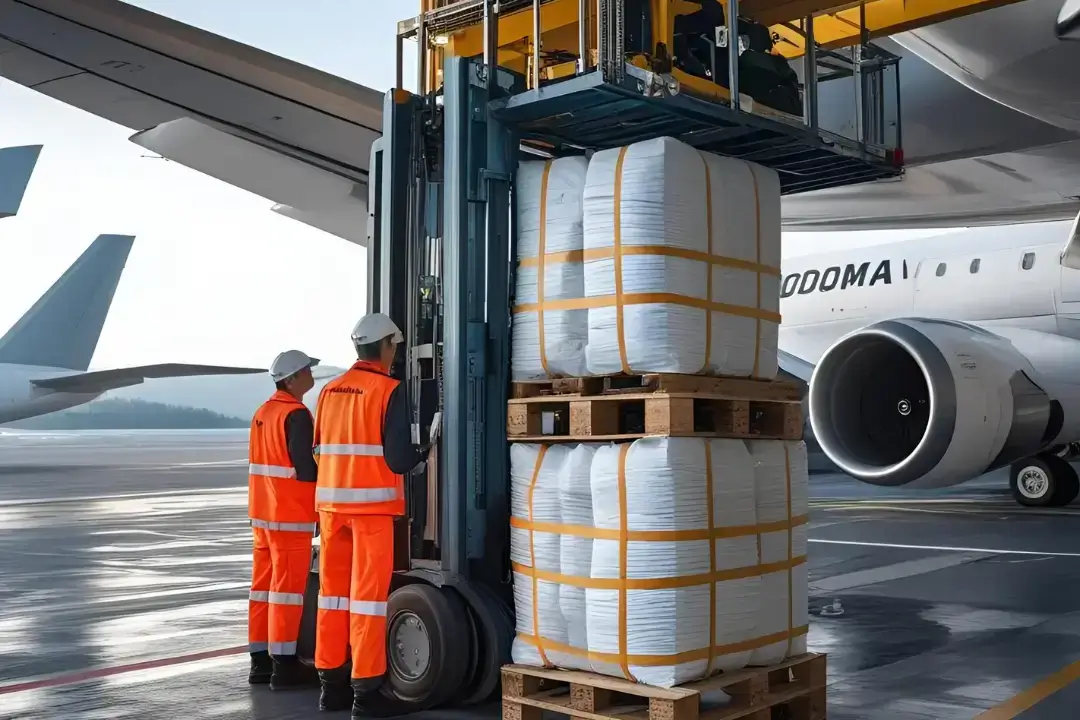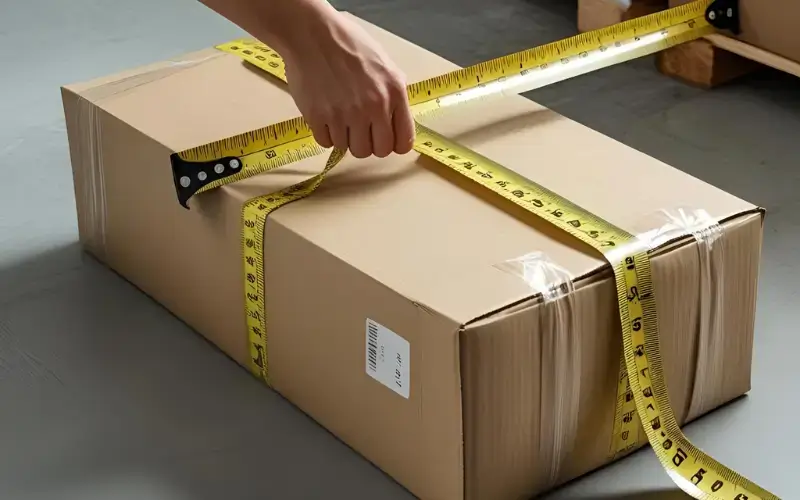How to Calculate Volumetric Weight for Air Freight Easily
Calculate Volume Weight and Save on Freight

Volumetric Weight Formula for Air Freight – Explained Simply
How to Calculate Volumetric Weight for Air Freight Easily ? Understanding how to calculate volumetric weight is essential in international air freight.
Airlines often charge based on the volumetric weight — the space a shipment takes up — rather than its actual weight.
Using the right Volumetric Weight Calculator helps avoid surprise shipping costs.
Standard Volumetric Weight Formula (IATA 6000):
Volumetric Weight (kg) = (Length × Width × Height in cm) ÷ 6000→ Example: A box measuring 100 × 80 × 60 cm = 80 kg.
Even if your shipment weighs only 30 kg, the airline charges for 80 kg because that's the space it occupies.
That's why calculating volumetric weight is crucial to avoid costly surprises on your freight bill.
To understand how volumetric weight compares to actual weight, check out Volumetric Weight vs Actual Weight in Air Freight.
✅ Why Do We Need a Volumetric Weight Calculator?
Manually calculating can lead to costly mistakes. Our free Volumetric Weight Calculator follows the official IATA divisor of 6000, making it fast, accurate, and simple to use.
Whether you're looking for a volumetric weight calculator for air freight, a chargeable weight calculator, or a shipping volume weight converter, our tool ensures accurate billing and smart logistics decisions.
Use the Volumetric Weight Calculator to compare actual weight vs dimensional weight and check if you're shipping bubble cargo — and avoid overpaying.
👉 Try Our Free Volumetric Weight Calculator Now.
Calculate volumetric weight in seconds
Why Volumetric Weight Matters in Air Freight
Airlines and freight forwarders don't just sell weight — they sell space.
If your shipment is bulky but lightweight (think foam, pillows, plastic containers), it consumes valuable cargo room.
That's why they calculate volumetric weight and charge whichever is higher: the actual weight or the volume-based weight.
Failing to calculate this properly can result in hundreds or even thousands of dollars in unexpected charges — especially for international shipments where accurate calculation is essential.
That’s why using a reliable Volumetric Weight Calculator for air freight is crucial for businesses shipping regularly.
📦 Real Case: A Costly Miscalculation
In 2024, one of our clients shipped lightweight foam panels:
Actual Weight: 20 kg
Dimensions: 150 × 100 × 60 cm
Volumetric Weight Calculation:
(150 × 100 × 60) ÷ 6000 = 150 kgThey expected to pay for 20 kg, but were invoiced for 150 kg, resulting in nearly $1,000 in extra shipping costs.
➡️ This resulted in nearly USD 1,000 in extra charges.
That’s why calculating volumetric weight in advance with a Volumetric Weight Calculator isn't just helpful — it's essential for cost control in air freight.
Volumetric Weight vs. Actual Weight
Airlines always use whichever is higher — actual or volumetric — as the chargeable weight. Here's how the differences break down:
| Type of Weight | What It Means | When It Matters |
|---|---|---|
| Actual Weight | The physical weight measured on a scale | Dense cargo like metals, machinery |
| Volumetric Weight | Space-based weight calculation (L × W × H ÷ 6000) | Bulky but lightweight goods |
| Chargeable Weight | The higher of actual or volumetric weight | Always used to determine billing |
Failing to check your volumetric weight for air freight is gambling with your freight budget.
That’s why experienced shippers always use a trusted Volumetric Weight Calculator before booking shipments — especially for air freight.
The IATA Formula for Volumetric Weight
The global standard set by IATA for international air freight is:
Volumetric Weight (kg) = (Length × Width × Height in cm) ÷ 6000✅ Always measure in centimeters
✅ Include outer packaging (pallets, cartons, wrapping)
✅ This divisor is based on IATA guidelines and is widely accepted by all major international airlines.
Note: While some express couriers like DHL or FedEx use a divisor of 5000, our Volumetric Weight Calculator is strictly built for international freight forwarding using the IATA-standard 6000 divisor.
🧮 Example Calculation
Imagine you're shipping a box:
Length: 120 cm
Width: 75 cm
Height: 65 cm
Calculation:
(120 × 75 × 65) ÷ 6000 = 97.5 kgEven if your shipment only weighs 40 kg, the airline will charge for 97.5 kg.
This makes a reliable Volumetric Weight Calculator for air freight essential for accurate planning and cost forecasting.
Every centimeter matters in air freight. That's why knowing how to calculate volumetric weight for air freight easily is crucial for cost management.

How to Reduce Your Volumetric Weight (and Save Money)
Freight professionals use these practical tactics to reduce unnecessary volumetric charges — and our Volumetric Weight Calculator can help you see the savings instantly:
✅ 1. Optimize Packaging
Use boxes that fit your product dimensions
Avoid excessive void filler
Eliminate empty space wherever possible
Before shipping, use the volumetric weight calculator for air freight to estimate potential cost savings.
✅ 2. Flat-Pack Your Items
Disassemble items like chairs, racks, or displays
Lowering the height can dramatically reduce volumetric weight
Example:
A box measuring 100 × 80 × 60 cm = 80 kg
Reduce height to 30 cm → volumetric weight drops to 40 kg
If the packaging changes, the billing will also change. We recommend that you use the Volumetric Weight Calculator to make an estimate.
✅ 3. Combine Shipments
Group smaller items into fewer boxes
Reduce empty space between individual items
Small reductions in dimensions can lead to significant savings, especially when you're using a reliable volumetric weight calculator, volumetric weight converter, or air freight volume calculator to guide your shipment planning.
Your Best Tool: Our Free Volumetric Weight Calculator
Manual calculations are prone to errors and can result in costly mistakes. Our professional Volumetric Weight Calculator simplifies the entire process:
✅ Fixed at the 6000 divisor (IATA standard only)
✅ Ideal for international air freight use
✅ Instant and easy to use — no math needed
✅ Helps check whether your goods are bubble cargo
Whether you're an eCommerce seller, manufacturer, or logistics manager — this is your essential tool for accurate shipping costs.
👉 Try our free Volumetric Weight Calculator today — avoid hidden fees, ship smarter, and save up to thousands on air freight costs.
| Scenario | Volumetric Weight |
|---|---|
| Box (90 × 70 × 50 cm), height 50 cm | 52.5 kg |
| Same box flat-packed to 25 cm height | 26.25 kg |
Every centimeter counts in air freight. That’s why using a Volumetric Weight Calculator — and knowing how to calculate volumetric weight for air freight easily — is your best defense against unnecessary shipping costs.
Final Tips for Smart Shippers
✅ Measure your cargo after packing — outer dimensions are what count
✅ Always use centimeters for consistency and compatibility with any Volumetric Weight Calculator
✅ Keep packing lists and invoices aligned with your measurements
✅ Don’t assume actual weight determines your price — always check volumetric weight using a calculator
The #1 mistake? Shippers relying only on scale weight — and getting shocked by unexpected volumetric weight charges.
✅ Avoid it by using our Volumetric Weight Calculator to compare both weights every time.

📘 Frequently Asked Questions
How do you calculate volumetric weight for air freight?
Use the formula:
(Length × Width × Height in cm) ÷ 6000This is the IATA standard for international air freight.
Why divide by 6000 in volumetric weight?
Because 6000 converts cubic centimeters into an equivalent weight based on an average cargo density of 167 kg/m³, as defined by IATA guidelines.
Can volumetric weight be less than actual weight?
Yes. If your cargo is dense and compact (e.g. metal parts), the actual weight might be higher than the volumetric weight. In those cases, airlines charge you based on the actual weight.
Is your calculator suitable for DHL or FedEx shipments?
No. Our calculator is designed strictly for international freight forwarders using the IATA standard divisor of 6000 — not for express couriers like DHL, FedEx, or UPS.
What is bubble cargo or volumetric cargo?
These are shipments that weigh very little but occupy significant space. Airlines charge these based on volume rather than actual weight, which can dramatically increase costs.
How can I reduce volumetric weight charges?
Use custom-sized boxes
Flat-pack products where possible
Eliminate empty spaces
Consolidate shipments to minimize dimensions
Even small reductions can lead to significant savings
Is this calculator suitable for sea freight or CBM?
No. Sea freight uses CBM (Cubic Meters) as the unit, and it doesn't convert directly into weight the same way. Our calculator is strictly for air cargo under IATA rules.
Related Articles
✈️ Ready to Save on Air Freight?
Knowing how to calculate volumetric weight for air freight easily is essential for accurately estimating both volume and freight costs for your shipments.
Use our free Volumetric Weight Calculator and stay in control of your shipping costs.
